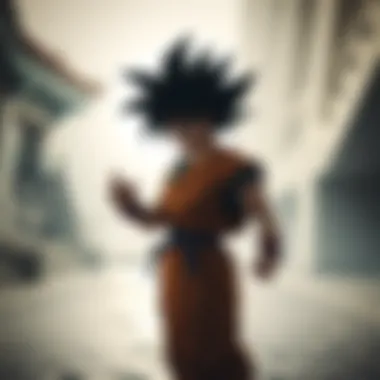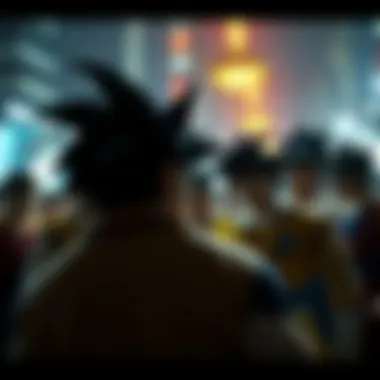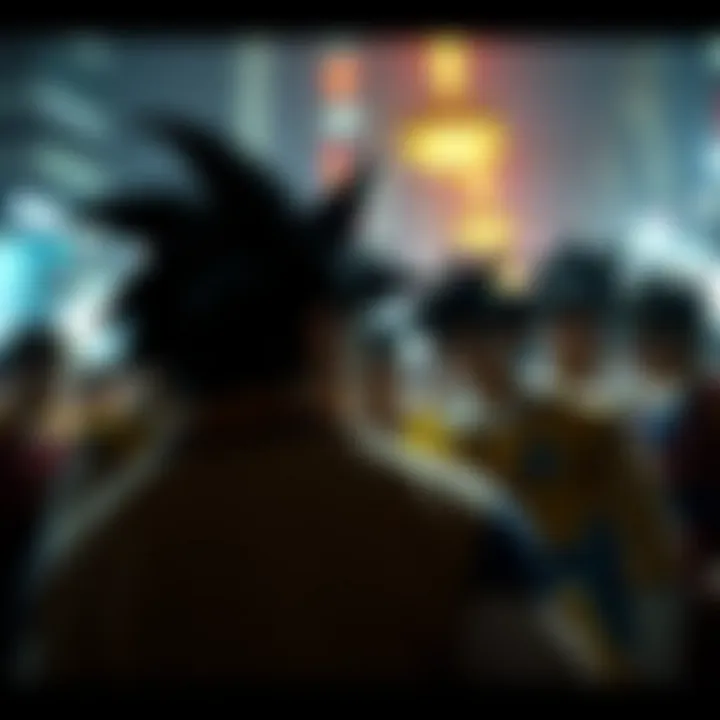A Comprehensive Analysis of Dragon Ball Z Episode 1


Intro
The world of anime has often been a shifting landscape, interspersed with trends that come and go like the wind. Still, some series stand the test of time, carving a place in the hearts of fans new and old. One such series is Dragon Ball Z, which kickstarted its legacy with an unforgettable first episode that laid the foundation for a franchise that continues to resonate in popular culture.
In this exploration, we will dissect the inaugural episode, diving into its plot intricacies, character introductions, and enduring themes. We won't shy away from examining how this single episode influenced anime and its broader impact on cultural narratives. Let’s buckle up and embark on this journey!
Industry Insights
Emerging Trends in Anime Industry
As we consider the landscape of anime today, it’s hard to ignore how foundational works like Dragon Ball Z have nurtured emerging trends. The influence of iconic series can be seen everywhere in today’s anime, from the narrative styles to character designs and even in merchandising approaches.
- Mixing Genres: A noticeable trend is the fusion of various genres, a concept that Dragon Ball Z engaged with. It combined elements of adventure, fantasy, and martial arts, paving the way for contemporary titles that don't shy away from genre-blending.
- Character Development: In recent years, there’s been a shift towards deeper character arcs. Dragon Ball Z introduced a diverse range of characters whose personal growth we followed through various story arcs, setting a precedent for newer series that prioritize emotional depth.
- Global Influence: The global reach of anime is also staggering. Once limited to Japanese audiences, series like Dragon Ball Z helped normalize anime in the West, leading to a growing acceptance and demand for international content, something that remains a trend.
Behind-the-Scenes of Popular Anime
Understanding the creative process behind Dragon Ball Z offers a glimpse into how the anime industry evolved. The production was handled by Toei Animation, which aimed to capture audiences immediately. Drawing inspiration from Dragon Ball, the aim was to amplify the animation’s intensity while preserving the charm of its predecessor.
In terms of art style and animation techniques, the colorful and vibrant imagery was not just about aesthetics; it was about creating a distinct identity. Key elements included:
- Dynamic Fighting Sequences: The blending of fluid animation with fast-paced action sequences made a mark on future fight scenes in anime.
- Character Designs: Characters like Goku and Vegeta became icons thanks to their distinctive designs that set a benchmark for future protagonists.
The first episode of Dragon Ball Z didn't just introduce its main characters; it established a visual language that is now a cornerstone of the genre.
Reviews & Recommendations
Must-Watch Anime Recommendations
As we venture further into the realm of anime sparked by the successful formula of Dragon Ball Z, a few recommendations can be made for fans seeking similar experiences:
- Naruto: An exploration of ninjas with deep story arcs and memorable fights.
- One Piece: A blend of adventure, humor, and colorful character dynamics that has stood the test of time.
- My Hero Academia: A contemporary series that embraces the spirit of heroism while exploring personal growth.
These series not only entertain but are also reflective of the impact that Dragon Ball Z has had on the anime industry.
Culmination
Examining the first episode of Dragon Ball Z puts into perspective its cultural significance and lasting legacy. Encompassing compelling storylines, character depth, and innovative art styles, it laid the groundwork for an entire genre. As we continue to analyze its influence, we discover its substantial role in shaping the narratives and artistic design found in contemporary anime.
For those wishing to learn more about the legacy of Dragon Ball Z, consider checking out resources like Wikipedia or Britannica. If discussions pique your interest, forums such as Reddit also offer rich conversations among fans.
Preamble to Dragon Ball Z
Understanding Dragon Ball Z is like peering into the very soul of modern anime culture. It represents not just a series, but a pivotal moment in animation history that shaped the genres we see today. The franchise's impact extends beyond entertainment, touching on themes of friendship, rivalry, and resilience which resonate deeply with audiences across generations. It’s crucial to appreciate how it builds on its predecessor, Dragon Ball, while carving out its own identity through more intense action and character development.
Franchise Background
Created by Akira Toriyama in the late 1980s, Dragon Ball initially captured hearts with its story of Goku’s whimsical adventures. However, as the years rolled on, fans craved something meatier—a deeper narrative combined with ferocious battles. Enter Dragon Ball Z, which debuted in Japan on April 26, 1989. The show didn't just serve up action; it laid down the gauntlet, introducing complex conflicts and darker themes.
While Dragon Ball largely focused on Goku’s growth as a martial artist, Dragon Ball Z expanded the story universe to explore the intricacies of Goku's heritage and the responsibilities that come with power. The show’s successful run for 291 episodes solidified its place in the realm of cultural phenomena, fostering an unparalleled fanbase and spawning a series of films, spin-offs, and merchandise.
Transition from Dragon Ball
The leap from Dragon Ball to Dragon Ball Z was not just a numerical one; it was a transformative shift. Unlike the earlier series that emphasized adventure and humor, Dragon Ball Z plunged into the depths of existential dilemmas and high-stakes battles. One could say it was like changing gears from a leisurely drive to a high-speed chase. The infamous Saiyan saga marked the transition, setting the tone with palpable tension and emotional stakes.
In this first episode, viewers were introduced to powerful new characters who would become pivotal to the unfolding saga, alongside familiar faces from Dragon Ball. This transition poses the question: what happens when a hero learns they are not just Earth's protector but also a warrior of a far more complex legacy? That idea runs through the entire narrative, setting a rhythm of discovery and intrigue that resonates with fans today.
With its unique blend of humor, action, and philosophical questions, Dragon Ball Z doesn’t just entertain—it invites us to ponder what it means to be stronger and what sacrifices must be made along the journey.
As we dive deeper into Episode 1, we will explore the essentials that make it not just a series starter, but a compelling introduction that sets the stage for the epic narrative that follows.
Overview of Episode One
In assessing the debut episode of Dragon Ball Z, understanding its overview is paramount. This first episode not only sets the stage for the series but also firmly establishes the thematic and narrative arcs that will evolve throughout the franchise. The significance of this episode lies in its ability to captivate viewers from the very onset, bridging the beloved Dragon Ball series with its more mature and complex narrative continuation.


Air Date and Reception
Dragon Ball Z premiered in Japan on April 26, 1989. From the get-go, it created quite a stir among anime enthusiasts. The initial reception was overwhelmingly positive. Fans who had fond memories of Dragon Ball were eager to see what came next, and they weren't disappointed. Not only did it revive the excitement for the franchise, but it also attracted a new audience who were curious about the adventures of Goku and his friends.
This episode embraced a darker tone compared to its predecessor, immediately making it clear that this was more than simple light-hearted adventures. The gravity of the episode's plot drew viewers in, making them feel every punch and every reveal. The audience's enthusiasm translated into impressive viewership numbers, cementing Dragon Ball Z's place in anime history.
Episode Summary
In the opening scene, viewers are thrust into a world that is both familiar and new. We find Goku, now an adult and a father, leading a peaceful life on Earth. Yet this tranquility is short-lived when Raditz, Goku's brother, arrives. This isn't just a typical family reunion. Raditz's revelation that Goku is not merely a human but a Saiyan warrior is a pivotal moment.
The episode is laced with intense moments that are key to understanding Goku's character and his legacy. The reality that he has been unaware of his true heritage adds a layer of complexity to his persona. The confrontation with Raditz escalates quickly, leading to Goku teaming up with Piccolo, a character who once was an adversary, showcasing the evolution of relationships amidst dire circumstances.
The dramatic introduction of conflict sets the tone for the entire series, where the stakes are high and friendship is intertwined with rivalry. This episode plants the seeds for themes that resonate throughout Dragon Ball Z, including the values of family, strength, and perseverance.
Through these carefully crafted moments, the episode engages viewers, pulling them into an expansive narrative that promises growth, conflict, and resolution as they navigate through the ensuing battles and character developments. For anyone looking to dive into the world of Dragon Ball Z, this episode is essential viewing. It’s a captivating plunge into a universe where heroism and camaraderie are tested against formidable foes.
Key Characters Introduced
In the very first episode of Dragon Ball Z, viewers are not just introduced to the story but also to key characters whose influence will ripple throughout the series. Understanding these characters lays a strong foundation for grasping the epic tale that unfolds. Each character offers something unique, contributing to both the narrative and the thematic depth of the show. Let’s delve deeper into these pivotal figures, reflecting on their roles and significance in this groundbreaking anime.
Goku
Goku, the central protagonist of Dragon Ball Z, is a character that embodies determination and an unwavering sense of justice. Having grown up on Earth, he is initially oblivious to his true origins, which are gradually revealed throughout the series. His carefree nature often masks a powerful warrior's spirit. In Episode One, Goku's interactions set the tone for what fans can expect – a blend of lightheartedness laced with hints of his serious responsibilities as a protector of Earth.
His character arc is a crucial aspect of the show, illustrating themes of growth and responsibility. The scene where Goku meets his son, Gohan, is laden with emotional depth, establishing the parental bond that drives many of Goku's decisions. Goku's ability to maintain a balance between his playful demeanor and fierce combat capabilities makes him a complex character that resonates with audiences across generations.
Gohan
Gohan, the timid and gentle son of Goku, brings a different energy into the mix. Unlike his father, he is not eager to fight; he's actually more interested in learning and living a peaceful life. His introduction in this first episode is not just to highlight the father-son relationship but to lay the groundwork for a character who, despite his initial hesitance, will play a pivotal role in the series. The show's implementation of Gohan’s character is crucial, as it reflects the theme of latent potential.
Interestingly, Gohan’s development mirrors Goku’s own journey but adds a layer of complexity with the expectations placed on him by both his father and the world around him. In the opening episode, as Goku gently encourages Gohan, viewers catch a glimpse of the inner conflict and growth that will soon unfold. This dynamic sets the stage not only for Gohan's evolution but also for the overall narrative, emphasizing the burden of legacy in a hero’s journey.
Piccolo
Piccolo's entrance into Dragon Ball Z represents a significant shift in the storyline. Initially introduced as a villain in the preceding series, he evolves into one of Goku’s strongest allies. This transformation is significant; it illustrates themes of redemption and alliances, particularly when Goku acknowledges his unexpected friendship with Piccolo. Their relationship is rooted in mutual respect, characterized by a unique blend of rivalry and camaraderie.
In Episode One, Piccolo’s intent to confront Goku and his warning about Raditz introduces tension that foreshadows future conflicts. His character serves as a counterbalance to Goku's naiveté and adds a strategic depth to the plot. The partnership that forms between Goku and Piccolo raises essential questions about trust and evolution in character relationships, making Piccolo an asset to the overarching narrative.
Raditz
Raditz, Goku's brother, is the character who triggers the unfolding drama and conflict in Dragon Ball Z. His arrival on Earth is nothing short of earth-shattering, presenting challenges that change the course of the story. Unlike the cheerful Goku, Raditz embodies a darker side, presenting the primal nature of Saiyans. His character introduces gravity to the narrative, serving as a catalyst for the significant revelations about Goku’s heritage and destiny.
By unmasking Goku's past and his connections to the Saiyan race, Raditz challenges his brother's values and determination. The dynamic between the two siblings is intricate, revealing elements of family loyalty versus responsibility to protect others. Raditz’s role in this first episode is not only to provoke Goku but also to lay the groundwork for the overarching battle between good and evil, making him a critical figure in establishing the stakes involved in the saga.
The multifaceted nature of these characters is what gives Dragon Ball Z its enduring charm, engaging audiences in a way that goes beyond typical hero narratives.
Plot Development
Plot development serves as the backbone of a narrative, giving it direction and purpose. In the very first episode of Dragon Ball Z, we see how plot elements are intricately woven to set the stage for drama, character growth, and overarching themes that would resonate throughout the series. The way the initial conflicts arise and resolve not only keeps viewers engaged but also lays crucial groundwork for future episodes. Each twist and turn in the plot often carries a deeper significance, prompting audiences to think critically about character motivations, moral dilemmas, and the implications of their choices.
Initial Conflict
The episode kicks off with a bang, introducing an immediate conflict that revolves around Goku's peaceful life being disrupted. When Raditz, Goku’s long-lost brother, arrives on Earth, he brings a threatening aura into the mix. The tension escalates, making it clear that Goku's past isn’t just a dusty memory; it is a pressing danger. This conflict serves as a catalyst for pushing the story forward. Not only does it provide suspense, but it also raises questions about familial bonds, loyalty, and the responsibilities that come with power. The struggle that ensues lays a solid foundation for a broader narrative, one that highlights the conflicts between the forces of good and evil.
Here’s what makes this conflict stand out:
- Immediate Stakes: Goku’s family, especially his son Gohan, become entangled in the fight. This intensifies the emotional stakes.
- Introducing Antagonists: Not only does Raditz pose a physical threat, but he also represents a philosophical challenge to Goku's identity.
- Plot Dynamics: The initial conflict is not merely a fight; it sets forth a chain reaction of events that will lead characters to push their limits, question their choices, and grow.
The Reveal of Goku’s Heritage
As the plot unfolds, the shocking revelation of Goku’s Saiyan heritage plays a pivotal role. Goku's background wasn’t just a fun fact; it acted as a pivotal turn that reshaped his identity and purpose. Learning that he is a Saiyan, a warrior race known for their ferocity and strength, significantly shifts Goku's understanding of himself and the world.
This revelation fleshes out several critical themes and considerations:
- Identity Crisis: Goku's reaction to learning his true origin invites viewers to explore the depths of personal identity.
- Legacy of Power: Discussion of Goku’s lineage opens the door to themes of legacy and responsibility. Will he embrace his Saiyan instincts, or will he choose to forge his path as a protector?
- Impending Threats: It hints at the mounting dangers from other Saiyans who may come looking for him, setting the groundwork for future conflicts.


By addressing Goku’s heritage right off the bat, the creators cleverly weave plot elements which keep audiences invested and longing to learn more about the universe they inhabit.
Goku’s Character Arc
In the inaugural episode, we witness the onset of Goku's character evolution. Initially depicted as a carefree martial artist enjoying life, the arrival of Raditz rocks his world and sparks a transformation. Goku’s response to the initial threats opens avenues for exploration of his values, strength, and vulnerabilities.
Key features of Goku’s arc include:
- Hero’s Journey: The episode unveils the early aspects of Goku's journey toward becoming a more vigilant and dedicated defender of Earth.
- Emotional Depth: Through Goku’s interactions, especially with his son Gohan, viewers catch a glimpse of his protective nature, which adds emotional weight.
- Struggle with Family Bonds: Goku’s conflict between his Saiyan heritage and his responsibilities as a father foreshadows deeper dilemmas that will arise later in the series.
The first episode of Dragon Ball Z not only sets the groundwork for exciting plots but also delves into rich character arcs. It intricately weaves together conflicts and revelations that capture the viewers, laying a solid foundation that will support complex storytelling as the series progresses.
Thematic Elements
The thematic elements in Dragon Ball Z Episode 1 hold substantial weight, as they set the tone for the series and encapsulate the essence of its narrative journey. By examining these themes, we can understand how they resonate not just within the episode but throughout the series as a whole. Two predominant themes emerge: family and legacy, alongside friendship and rivalry. These motifs intertwine, providing depth to the characters and stirring emotional connections with the audience.
Family and Legacy
In the heart of the episode lies the theme of family and legacy. Goku is introduced as a father and a warrior, juggling his responsibilities as a parent while facing a significant threat from his own brother, Raditz. This duality makes Goku relatable in many ways; he is a fighter at heart but also deeply cares for his son, Gohan. The conflict he faces prompts viewers to contemplate the burdens of heritage and the expectations carried down through generations.
Goku's heritage isn't just a backdrop; it's pivotal. The revelation that Goku, despite being raised on Earth, is in fact an alien being raises questions about identity and belonging. This theme of legacy reflects broader societal concerns about familial responsibilities and the influence of one's origins. In many cultures, the weight of a family name can be a double-edged sword, leading to expectations that can either inspire greatness or set the stage for failure.
"Family isn’t just an important thing; it’s everything."
Additionally, Gohan's character arc introduces the theme of potential and destiny. As the son of Goku, expectations follow him like shadows. His interactions with Goku underscore the warmth of their bond while simultaneously emphasizing the challenges of living up to an illustrious legacy. Goku’s hope for Gohan to embrace a peaceful life, free from conflict, juxtaposes the harsh realities presented by Raditz. This tension reflects the complexities many parents face: the desire to protect their children from the world while also preparing them for inevitable challenges.
Friendship and Rivalry
The theme of friendship and rivalry introduces a compelling dimension to the episode, particularly highlighted through the contrasting characters of Goku and Piccolo. Initially introduced as enemies, their relationship evolves throughout the series. At this juncture, however, the dynamic sets a stage ripe for exploration of personal growth through competition.
In Episode 1, this rivalry is on the surface, yet it foreshadows a deeper alliance. The audience is left with the impression that conflicts often breed the strongest bonds, and through struggle, both Goku and Piccolo will ultimately find common purpose. This theme resonates with viewers, emphasizing that true strength often comes from working together, even among those with a history of animosity.
The relationship between friends and rivals illuminates the struggle each character faces in mastering their skills while pushing each other to grow. As Goku prepares for the impending battle, the audience sees both respect and tension between characters. It highlights that rivalry isn't purely negative; it can propel individuals towards greatness and foster profound connections.
In summary, the thematic elements of family, legacy, friendship, and rivalry in Dragon Ball Z Episode 1 are intricately woven together, creating a rich tapestry that underpins the emotional weight of the series. These themes not only enhance narrative depth but also resonate with timeless human experiences, engaging viewers in ways that extend far beyond animation, making it a cherished part of pop culture.
For further reading and exploration of these themes, you can visit:
Artistic and Animation Choices
In an era brimming with animation styles, Dragon Ball Z strikes a unique chord with its artistic and animation decisions. These choices not only amplify the storytelling but also contribute significantly to the series' popularity and long-lasting impact. A closer look reveals how these creative decisions play a key role in engaging the audience and enriching their experience.
Character Design
The character design in Dragon Ball Z is one of its most recognizable elements. Each character boasts a distinct aesthetic that reflects their personality and story arc. For instance, Goku's spiky black hair and orange gi are not just iconic but functional; they communicate his youthful energy and relentless spirit.
In contrast, Raditz, Goku's brother, features a more menacing design, complete with a long tail and armor that signifies his Saiyan heritage. Such design choices are intentional—they illustrate the contrast between the characters while enhancing visual storytelling.
Some notable features include:
- Color Palette: The use of bright and vibrant colors makes characters pop, drawing the viewer's eye and creating a sense of action and excitement.
- Exaggerated Features: Characters possess exaggerated facial expressions and body proportions, leaving a lasting impression and conveying emotions effectively.
The nuances in character design echo the show’s wide-ranging themes—good versus evil, the struggle for identity, and the complexity of familial bonds. As the series progresses, the characters evolve visually, showcasing growth and change, which keeps the audience invested.
Action Sequences
When it comes to action, Dragon Ball Z is in a league of its own. The animated fight scenes are known for their fluidity and intensity, a combination that resonates deeply with fans of the genre. The artists took great care to represent movement realistically, using techniques like motion blur and dynamic angles to immerse the viewers in the chaos.
A few vital elements contribute to the effectiveness of these action sequences:
- Choreography: The fight sequences are choreographed with precision. Movements are carefully constructed to convey the weight and power of each punch or energy blast.
- Sound Effects and Music: The accompanying sound effects and dramatic musical score amplify the viewing experience. The beats drop in synch with major hits, adding a layer of excitement.
- Visual Effects: The use of energy blasts and auras, illustrated with bright colors, not only signify power levels but also visually distinguish one fighter from another. These effects create a spectacle that is both exciting and visually appealing.
Ending


Artistic and animation choices in Dragon Ball Z significantly elevate the narrative, offering a blend of high-impact storytelling and captivating aesthetics. From character design to dynamic action sequences, every aspect is carefully curated to engage the audience fully, ensuring that the series not only entertains but also leaves a lasting mark within the anime landscape.
The animation choices in Dragon Ball Z are a testament to the artistry of anime, merging form and function to create a memorable viewing experience.
This commitment to quality in aesthetics and action solidifies Dragon Ball Z's status as a classic in the anime world.
Cultural Impact
The cultural impact of Dragon Ball Z is nothing short of monumental, solidifying its place in both anime history and global pop culture. The first episode set forth a series that would captivate generations and create an entire subculture that thrives even today. From the moment Goku and Gohan are introduced, viewers are not merely spectators; they become part of a larger narrative that celebrates resilience, friendship, and the never-ending battle between good and evil.
This initial airing wasn’t just an introduction to characters, but a community was born. Fans began gathering around screens, sharing their thoughts, and creating fan art. The stakes were raised, and soon it was clear: Dragon Ball Z became a landmark series that not only influenced other anime but also made its mark on other forms of media such as video games and comics.
Reception in Japan
Upon its debut in Japan on April 26, 1989, Dragon Ball Z was received with much enthusiasm. The nostalgia factor for fans of the original Dragon Ball series played a significant role in its success. Viewers were excited to watch beloved characters transition into more complex, mature roles. The blend of action, humor, and emotional depth resonated strongly with audiences. Notably, the animation quality was considered a step up from its predecessor, enhancing the viewing experience.
Market data indicated that viewership skyrocketed, quickly positioning Dragon Ball Z as a staple of Japanese television. It became a catalyst for merchandise sales, generating toys, video games, and collectibles that would soon flood the market.
"In Japan, Dragon Ball Z wasn't just a show; it became a cultural phenomenon, inspiring everything from schoolyard fights to fashion trends."
Global Influence
The ripple effect of Dragon Ball Z spread far beyond the shores of Japan. As the series made its way to Western audiences in the 1990s, it brought with it a fresh approach to storytelling in animated shows. The themes of personal growth and the struggle against overwhelming odds resonated universally. In turn, this encouraged other anime to explore deeper narratives, often compressing elements of action and drama into a single episode.
Numerous anime series that followed in the years afterward owe a debt to the groundwork laid by Dragon Ball Z. The show set expectations high for character development and dynamic battles. Today, we can trace influences in popular titles like Naruto and One Piece, which mirror the conventions first established by Dragon Ball Z.
As its popularity increased across various platforms, Dragon Ball Z even crossed over into mainstream Western pop culture, being referenced in everything from music to television shows. The term 'Super Saiyan' has slipped into everyday lexicon, a testament to the series' reach and relatability.
In summary, the cultural impact of Dragon Ball Z is profound. It not only shaped the anime landscape but also transformed entertainment as a whole into an interconnected web of influence across generations and borders.
Comparative Analysis with Other Anime
When exploring the impact and significance of the first episode of Dragon Ball Z, it is crucial to place it within a broader context of the anime landscape. This comparative analysis sheds light on the distinct features and narrative styles that not only set Dragon Ball Z apart but also paved the way for future series.
Distinct Features of Dragon Ball Z
Dragon Ball Z carries a legacy marked by its very own unique elements that resonate with audiences. One of the most prominent features is its blend of action, humor, and heartfelt moments. This mix ensures that the series is not merely a collection of fight scenes but also a story about growth, friendships, and familial bonds. Unlike many anime counterparts that focus solely on character or plot development, Dragon Ball Z thrives on a balance of both.
- Character Growth: Characters like Goku and Gohan evolve not just in power, but personally. Goku transforms from an innocent child to a determined protector, while Gohan pivots from being a timid kid to an essential figure.
- Long-Form Storytelling: The show introduces arcs that allow characters to develop over time, unlike episodic formats seen in other series.
- Over-the-Top Power Levels: The emphasis on power levels may have started a trend in shonen genres, where battles become battles first to showcase improved skills and abilities rather than just plot points.
- Unique World Building: The fantastical elements, ranging from alien worlds to mystical powers, create a universe that captivates viewers, distinct from more grounded storytelling in other anime.
These features not only define Dragon Ball Z but also influence how audiences appreciate action and adventure anime.
Influence on Future Anime Series
The ramifications of Dragon Ball Z extend far beyond its air date. It has undeniably shaped countless anime series that followed, leaving an indelible mark in narrative structure, character designs, and thematic undertones.
- Character Archetypes: Many of the character types and tropes established by Dragon Ball Z, such as the strong yet kind-hearted hero or the determined underdog, have become staples in subsequent series. Shows like Naruto and One Piece draw on these narratives to build their own worlds.
- Focus on Training and Growth: The time dedicated to training, often depicted through rigorous training montages and mental challenges, has inspired series like My Hero Academia, where character development plays a paramount role.
- Epic Battles: The series harnesses the essence of grand, high-stakes battles, inspiring titanic confrontations in later works. Consider the climactic fights in Attack on Titan, where stakes are always sky-high, reflecting a similar sense of urgency and intensity seen in Dragon Ball Z episodes.
In summary, Dragon Ball Z did not just carve its own path; it lit the way for future creators to explore realms of action, adventure, and emotional storytelling. Understanding these elements underscores why the series remains a foundational pillar in anime history.
End
In examining the inaugural episode of Dragon Ball Z, it becomes clear that this episode is not merely an introduction but a cornerstone in the anime narrative that would reshape the landscape for years to come. This episode illustrates the blend of action, character development, and thematic depth that distinguishes Dragon Ball Z from its predecessors and contemporaries alike.
Summation of Episode One's Importance
Episode one sets a pivotal stage for the unfolding saga. The plot begins with Goku, a character familiar to fans of the prior series, Dragon Ball. However, this episode brings a heightened sense of urgency and stakes, introducing the concept of Gohan's safety and Goku's lineage—elements that resonate throughout the series. The appearance of Raditz, Goku's brother, is not just a twist but a significant narrative push that introduces viewers to the conflicts that will define Goku’s character arc. The dynamic introduced here lays the groundwork for crucial relationships and rivalries, effectively drawing the audience into the world of Dragon Ball Z.
"Goku's heritage is more than just a family secret; it's the lens through which the series explores what it means to be a hero. The stakes are immediate, personal, and universal."
The importance of this episode lies in how it encapsulates the series' core themes—family, legacy, and the endless pursuit of strength—while laying a foundation for evolving character interactions. This layered storytelling not only captivates the audience but sets a precedent for future episodes and arcs.
Anticipation for Future Episodes
After witnessing the tension and drama packed into the first episode, viewers are naturally drawn to what's to come. With the introduction of Piccolo as a reluctant ally, coupled with the menace posed by Raditz, there is an air of anticipation about how these characters will evolve. Fans and newcomers alike ponder whether Goku will embrace his Saiyan heritage or strive to forge his own path, resisting the call of his bloodline. The promise of conflict with more powerful foes, and the exploration of Goku and Gohan’s relationships, enhance the allure.
Furthermore, the episode serves as a launching pad into a series that thrives on escalating stakes, intense battles, and moral dilemmas. With every new episode, the stakes grow higher, inciting viewers to remain engaged as they follow characters who not only grow stronger but grapple with their identities and destinies.
The anticipation built by this first episode is a testament to its success. It encapsulates not just the immediate thrills but also the broader narrative that will unfold, encouraging viewers to journey alongside these characters through conflicts and triumphs, intertwined with lessons about resilience and transformation.
In summary, Episode One of Dragon Ball Z is significant not only for its immediate impact but for how it sets the stage for a sweeping narrative that has wowed audiences for decades. It is an invitation into a rich world of adventure that continues to resonate across generations.



